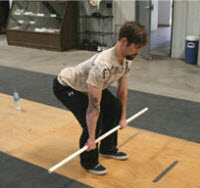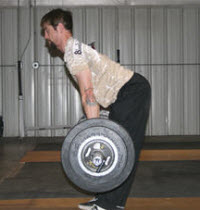
The dead lift movement is done every time we pick something up off the ground. When done correctly it causes the greatest contraction of the muscles of the core.
Fitness itself means many things to many people but,for the purpose of this article, we will say that our fitness level is relevant to how it either positively or negatively affects our ability to carry out the functions of our daily existence. We will also assume for the time being that very few of us are professional athletes. If that is true, then it becomes understood that we need to accomplish several different types of tasks throughout the day, very few of which involve isolating one muscle group from another.
This concept is more readily applied to the population on a large scale. Housewives/mothers have to carry babies, chase kids, do laundry, shop, clean house, and accomplish various other tasks. Law enforcement officers have to be spry on their feet, may need the strength and endurance to engage in lengthy foot pursuits of suspects, and potentially have to defend themselves or the public with their hands or perhaps their firearms. Hunters need to be able to hike in and then, if they get lucky, pack out their quarry. Office workers …oh, that’s right, they pick up those five-gallon bottles of water for the water dispenser. We all fall somewhere on the spectrum.
Considering all the facts, does it then make sense to spend our limited training time frolicking around the gym on inflatable balls like a circus performer? How about the more commonplace biceps curl—where does that fit in? While there is a place for gym training, I would say that for the overwhelming majority of us, we would be better served by moving our bodies in space, picking things up, throwing things and developing skills like balance in the types of patterns that we use during the course of our day.
Regardless of what we call our pursuit of fitness (I utilize a program called CrossFit, which can be further investigated here: www.crossfit.com), we want it to develop our fitness capacity in a way that makes our daily lives easier. The movements that we use in the gym (or out of it, if you tend toward long-distance style workouts) should exist outside of the gym, and the equipment that we use should allow us to properly mimic the movements that we use outside of the gym. These are functional movements, and this is the essence of functional fitness.
CrossFit defines these movements as having the “unique ability to move large loads (relative to non-functional movements) long distances, quickly.” Ironically, these are movements that are quickly recognized in places like construction sites, grocery stores and even homes. They are compound (involve more than one joint), complex (more nuanced than the aforementioned biceps curl), and will cause changes both in muscularity and neurological function.
One such movement is the dead lift. This is a movement that is used by each and every one of us on a daily basis. It happens each time we pick something up off the ground, or at least it should. The human body can be looked at as a series of pulleys and levers, and just like that Erector Set that a lot of us had as children, it can be put into positions that allow for efficient movement.
With the dead lift, this positioning should happen without respect to the weight being lifted. In other words, it doesn’t matter if we are picking up our car keys, a bag of concrete, or our children. Certain things should happen each and every time if we are going to move efficiently, get strong and hopefully avoid injuries.
 Most of us have heard the phrase “Lift with your legs, not your back.” This concept has been spread far and wide and is unfortunately incomplete at best. Whenever we pick something up from the ground, we use our back to some degree. In fact, the dead lift has the singular distinction of causing the greatest contraction of the muscles of the core (the muscles in your pelvis, lower back, hips and abdomen). When we pick something up properly, we use most of the muscles in our body, and since we know that we’re going to pick things up, let’s learn the right way to do it, both for training purposes and even some of the concepts for applying that strength to our daily life.
Most of us have heard the phrase “Lift with your legs, not your back.” This concept has been spread far and wide and is unfortunately incomplete at best. Whenever we pick something up from the ground, we use our back to some degree. In fact, the dead lift has the singular distinction of causing the greatest contraction of the muscles of the core (the muscles in your pelvis, lower back, hips and abdomen). When we pick something up properly, we use most of the muscles in our body, and since we know that we’re going to pick things up, let’s learn the right way to do it, both for training purposes and even some of the concepts for applying that strength to our daily life.

When learning the dead lift, start with as little weight as possible. Use a broomstick or PVC pipe and focus on getting your body into the correct position for executing the dead lift.
The first step is to place your feet directly under your hips. This is a fairly narrow position for most people, but it is a position of great power. Your toes should be ever so slightly pointed out. Grip the broomstick with both palms facing behind you at about three inches outside of your hips. Bend over so that the stick comes to about the middle of your shins. Lower your backside so that the angle at the back of your knees is about 45 degrees (keep in mind that everyone’s body is different, so don’t get too wrapped up in measuring angles). Now leave your butt where it is and begin to elevate your chest by arching your back.
I’m now going to rant a bit: This flat or neutral back position is one of those things that should be present each and every time you pick something up. At the point at which your back rounds out, you are no longer doing a dead lift and are putting yourself at much greater risk of injury. This is the point that is missed by the “legs, not back” concept, and missing it has caused thousands of back injuries and countless thousands of dollars in workman’s comp costs. If you know you are going to pick things up, learn how to do it right.
Your eyes should be looking at the ground about 10 feet in front of you. At this point, your shoulders should be over or slightly in front of the barbell. Take a deep breath and fill your abdominal area with air. From here, stand up, keep the stick in contact with your legs the whole way and DON’T lose that arch position in your lower back.
 To replace the weight, push your backside and knees back, keep your arms long and, when the bar is level with your knees, bend them and put the stick back where it started.
To replace the weight, push your backside and knees back, keep your arms long and, when the bar is level with your knees, bend them and put the stick back where it started.
Once you have learned how to accomplish the movement safely, you can start to add some weight. Move the weight up progressively until you start to feel your form fall apart. At this point, it is time to stop. In time you will become stronger and be able to lift more weight. More importantly, if you apply these same techniques to picking things up from the ground in life, you are a lot less likely to injure yourself and will probably be able to move more efficiently throughout the day.
This is the first in a series on functional fitness. In future installments I’ll take you step by step through other movements and exercises that will positively impact your ability to do the tasks you perform in your daily life. Functional fitness is simple, smart and will make you stronger in ways you’ll see every day. Don’t waste time with anything else!
I'm 71 years old and after many years of body abuse I don't have too much still working properly but my back is the only thing still good because I learned young and have always tried to not abuse it. The trouble is: the rest of me couldn't fight my way out of a paper bag. Is there any hope for me? Otherwise I'll leave your fabulous training to someone who can get the best of it and keep on working on my shot placement.
When do you expect the "future installment so"to be available"?
Wonderful website. A lot of useful info here. I am sending it to several buddies ans additionally sharing in delicious. And naturally, thanks in your effort!